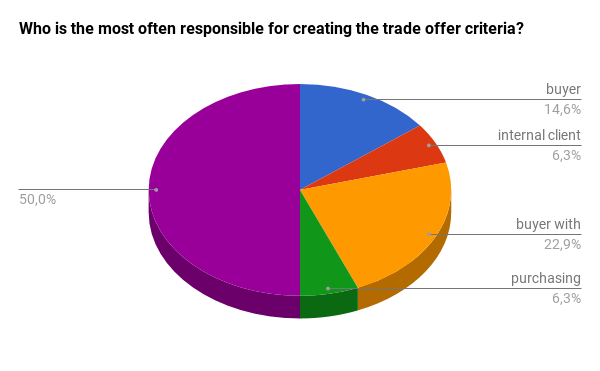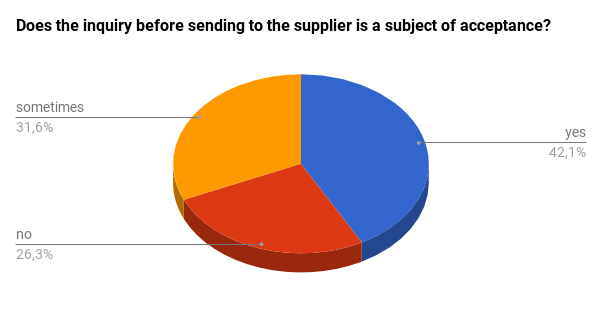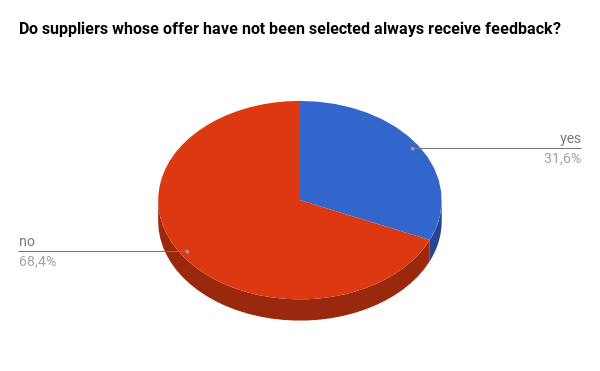An efficient offer inquiry

Offer inquiries are one of the basic tools for communication between merchants and suppliers in the sourcing process. Their use mainly affects the efficiency in obtaining offers, but also the communication and ultimately the image of the buying company. In many situations, the approach to the inquiry is closely related to the amount of work involved in a particular procurement project. The following article presents the company’s approach to the execution of offer inquiries, based on a survey conducted in June 2017.
Functions of an offer inquiry
An offer inquiry is primarily used to inform the market about the business needs of the buying company. It is common practice to send inquiries regarding the current needs of a given undertaking. Many companies utilize the RFX methodology, with the inclusion of RFI, RFP, and RFQ tools, which allows for efficient management of the offer collection process, particularly in complex issues that require an in-depth market analysis and a modification of business needs. At the same time, the inquiries may result from needs other than just obtaining offers related to current needs. Such purposes we can include e.g. the extension of the supplier base without no current demand. Such a base will be the basis for the execution of subsequent activities within the framework of the executed procurement. An interesting practice is also to systematize the collection of uncalled offers in order to build a knowledge base regarding the market and to improve communication with suppliers. Another example may be continuous inquiries, reduced in practice to an endless dynamic auction, from which buyer can utilize at any time. The above analysis allows for the conclusion that in different situations companies can use differentiated strategies for communication with suppliers in order to obtain trade offers.
Description of business needs
The starting point for developing a current inquiry is to define the business needs of the undertaking. The needs may relate directly to the specifications of a given product, but also to the expectations regarding the terms of cooperation. Some of them may be static and formal, which in practice means the need for the suppliers to adapt to those expectations. The description of business needs should be linked directly to the market to which the inquiry will be sent. The contents of an inquiry may narrow or expand the market, thereby increasing competition and the likelihood of obtaining more favorable trade offers. The key business issue is to determine who should be responsible for this process. On one hand, internal customers tend to have more substantive knowledge in practice, but they are also less interested in the economic aspect. The solution may be to create a category manager position within the organizational structure, whose know-how in the area of procured procurement categories should be presumably higher.
Assessment criteria
Selection of a trade offer should, in principle, be based on assessment criteria. From the point of view of effective management of the procurement process, it is important to know how such criteria are created and what their method of acceptance, monitoring and control is. The issue is similar to defining business needs, which particularly involves as to whether internal customers should be the ones responsible for defining the criteria, or should it be done by merchants, or task teams. Of course, the solution chosen should depend on both the nature of the procurement category and the value of the executed procurement. The chart below shows the businesses’ approach to the method of creation of assessment criteria:

In the vast majority of situations (approx. 90%), the people representing the procurement department have an impact on the final shape of the accepted assessment criteria. In the case of 45% of the inquiries, merchants set out the criteria together with the clients, and only in case of about 10% of inquiries the task is carried out independently. Interestingly, in about 10% of procurement proceedings the manager is responsible for this task. Merchants set the assessment criteria for about 30% of the offer inquiries executed by themselves. At the same time, the offer queries are accepted by managers in every situation in the case of 42% of the inquiries, and occasionally for about 30% of the inquiries, as shown in the chart below:

Transparency
The transparency of the procurement activities on one hand facilitates control and ultimately process management, on the other hand – it increases the competitiveness and attractiveness of trade offers. In order to achieve satisfactory transparency, undertakings utilize varied measures when submitting offer inquiries. In some companies, the common solution for procurements of considerable value are tender commissions. A relatively easy solution is the principle of the use of closed envelopes, which is reduced in practice to the lack access to the offer until the collection of offers is completed. Of course, such a concept is not without its drawbacks and the possibility of its application results from the business context for a given inquiry. For 42% of undertakings, closed envelopes are the primary principle of execution for offer inquiries, 26% of them use it from time to time, and 32% of businesses never utilize such a practice.

